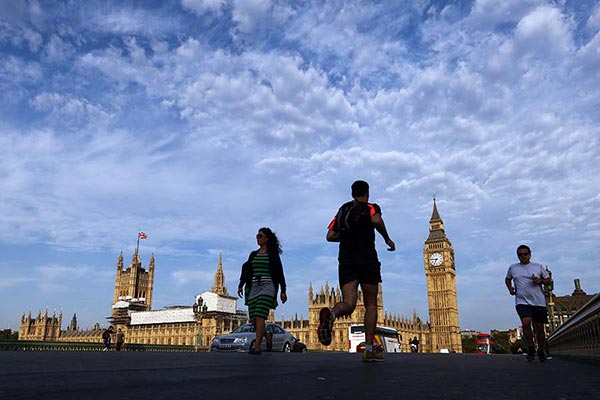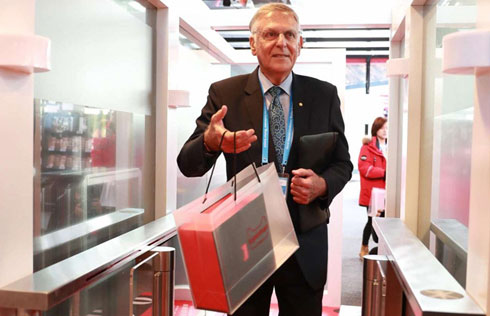Festival showcases Guangdong's tourism potential
|
Left: A lion dance is performed at the start of the Qiu Se parade last weekend in Foshan. Right: A boy dresses as an ancient general for the parade. Photos Courtesy of Southern Metropolis Daily |
|
Left: A parade float displays models of autumn fruit. Right: Foshan kung fu is demonstrated on stage at the beginning of the parade. |
The 2015 Guangdong International Tourism and Culture Festival was held in Foshan over the weekend, with more than 900 guests treated to a feast of the host city's folk culture to showcase the growth potential of its tourism industry.
Agreements for 31 projects were signed at the festival, with total investment of 52.56 billion yuan ($8.32 billion). Of these, 21 will be located in Foshan, seven in other cities in Guangdong province, and three are partnerships between tourist agencies in Guangdong and scenic spots in the provinces of Yunnan, Hubei and Jiangxi.
Launched in 2005, the Guangdong International Tourism and Culture Festival has become an important platform for the South China province to showcase its tourism resources and promote exchanges and cooperation between Chinese and foreign tourism and cultural industries, according to Zhao Yufang, deputy governor of Guangdong.

"The provincial government attaches great importance to developing tourism, which strongly supports the province to maintain steady, healthy economic growth," Zhao said at the festival's opening ceremony on Saturday, which Zhu Xiaodan, governor of Guangdong, also attended.
The tourism revenue of Guangdong reached more than 920 billion yuan last year, contributing to 6.3 percent of the province's GDP, Zhao said.
"Tourism is a big driving force for the economy and employment," Wu Wenxue, deputy director of the national tourism administration, said. "It has maintained rapid growth in spite of the downward pressure on China's economic development."
Tourism in China attracted more than 550 billion yuan in direct investment in the first three quarters of 2015, seeing year-on-year growth of 29 percent, Wu said. That growth rate was 17 percentage points higher than that of the entire tertiary industry, he added.

"Tourism, which used to be a periphery sector, has entered the main field in economic development and become an important player to stabilize growth, adjust structures and improve people's livelihoods."
Foshan is the cradle of the culture of Lingnan, a region encompassing the three southern provinces of Guangdong, Hainan and the Guangxi Zhuang autonomous region.
The Foshan government has been beautifying its landscapes and upgrading public facilities since 2012 to provide residents with a better living environment. While building modern facilities, the city has also made a great efort to preserve historical sites and obtain value from its cultural heritage.
For example, a scenic area has been developed on the site of the Ancient Nanfeng Kiln, which has been continuously firing for more than 500 years. Simon Millcock, a member of the planning and development department of the city council of Townsville, Foshan's sister city in Australia, attended the festival and toured Foshan.
"I like what they did to preserve the city's old part and am also impressed by the city's beautiful new look," he said.
"We are filming a video of Foshan during the visit. We want to promote Foshan to people back in our city by showing them what Foshan looks like and, more importantly, how people live their lives here."
"A city beloved by its people will be loved by visitors," said Xie Jianhua, deputy director of the tourism administration of Foshan. "That's why we want to engage not only our guests but also the general public in the tourism and culture festival."
Highlights of the festive weekend included a food festival, a dragon boat race that involved 16 teams from across Asia, and the Qiu Se parade.
The Qiu Se, or autumn colors, parade started during the Ming Dynasty (1368-1644) to celebrate the harvest. Since 2009, the Foshan government has organized the Qiu Se parade every year in late October or early November.

This year, about 2,000 performers in 36 troupes from across the country and abroad joined the parade.
All 21 cities in Guangdong, nearby Hong Kong, the Guangxi Zhuang autonomous region and Guizhou province, and Foshan's three partners in the alliance of "China's Big Four Towns" - Wuhan in Hubei province, Jingdezhen in Jiangxi province and Kaifeng in Henan province - displayed their folk performances.
Foshan's sister cities in South Korea, Russia and Australia were also invited to add exotic color to the Qiu Se parade.
"Folk culture is one of the biggest tourist attractions for visitors from worldwide," said Zhang Weiqiang, dean of the tourism management and planning academy at the Guangdong University of Finance and Economics.
"However, besides a show, tourists want to see how folk culture is practiced in local people's lives and have a firsthand experience of it," he said.
Zhuhai will host the next Guangdong International Tourism and Culture Festival in 2017.
xujingxi@chinadaily.com.cn
(China Daily 11/03/2015 page12)










